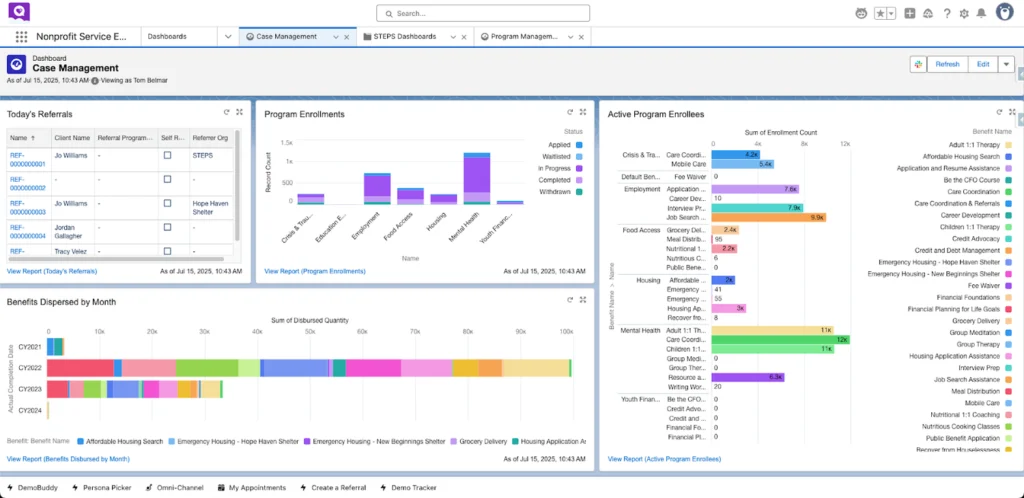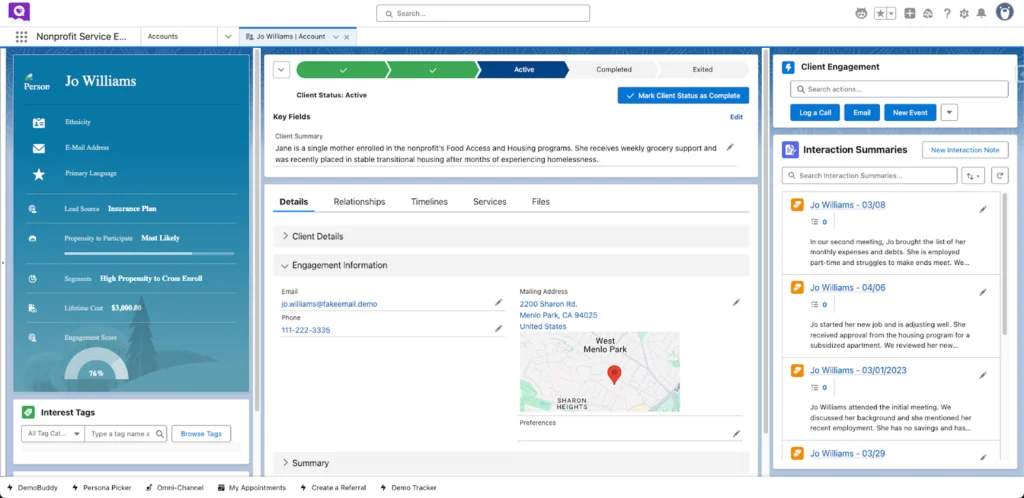This article was written by Cole Berry, Salesforce Solutions Architect.

Nonprofits do big work with lean teams. The ones we partner with are on the front line every day—supporting families, coaching young people, housing neighbours, and connecting clients to vital services. More and more of these organisations are moving to Salesforce Nonprofit Cloud Case Management to manage that work end-to-end. When it’s implemented well, case management stops being a stack of spreadsheets and becomes the engine of consistent, person-centred service delivery.
Why great case management changes outcomes
Strong case management is not about logging transactions. It’s about seeing the full client story, tracking needs and goals, and making sure each touchpoint moves someone forward. With the right structure in place, staff deliver more personalised support, reduce drop-offs, and improve outcomes at the individual and community level. Just as importantly, leaders get the visibility to allocate scarce resources where they matter most.
What sets Salesforce Nonprofit Case Management apart
Built for nonprofit realities. The platform is highly configurable, so you’re not forced into one rigid process. Track client intake, assessments, service plans, referrals, case notes, and outcomes in ways that mirror your programs.
A single source of truth. Instead of hopping between systems, everything sits in one CRM. Teams can see real-time client progress, waitlists, and program capacity in dashboards—turning data into decisions.
Ecosystem integrations. Salesforce plays nicely with fundraising tools, volunteer management, finance, learning, and productivity suites. That removes data silos and connects program delivery with development, finance, and operations for a 360-degree view of your organisation.
Security and permissions. Granular access controls help protect sensitive information while letting cross-functional teams collaborate confidently.

Collaboration tools that keep teams in sync
Nonprofit work is a team sport, often spread across offices, outreach sites, and home visits. Because Salesforce Case Management is cloud-based, staff can log in anywhere, capture case notes on the go, and see the latest updates in real time. Embedded collaboration (comments, task assignment, file sharing) makes it easy to coordinate care, flag risks, and keep momentum between appointments.
For fundraisers and partnership managers, mobile access puts donor and campaign context in hand—handy before a meeting or site visit. Everyone stays aligned without extra status meetings.
Automation that scales quality and consistency
Automation isn’t just about speed; it’s how you scale best practice. With Salesforce you can:
- Standardise client intake with guided flows and validation rules
- Auto-schedule check-ins, send reminders, and reduce no-shows
- Trigger tasks when risk scores change or when a referral is accepted
- Generate templated service plans and close-out summaries
By taking repetitive admin off people’s plates, staff spend more time on the high-touch, human work—relationship building, coaching, advocacy—while clients get a consistent experience regardless of who is on duty.
Data you can use to drive impact (and funding)
Real-time reporting turns program data into insight. Leaders can see:
- Who is progressing and who is stalled
- Which sites or cohorts need attention
- Service utilisation, wait times, and outcomes by program
- Grant and contract reporting metrics in one click
When grant season rolls around, you’re not chasing numbers across multiple tools. Dashboards and visualisations help demonstrate scale, impact, and equity—evidence that builds credibility with funders, boards, and community partners.

Practical ways organisations use Salesforce Case Management
- Housing & homelessness services: Streamline intake, track eligibility, prioritise placements, and coordinate wrap-around services with partner agencies.
- Youth & education programs: Monitor attendance, interventions, mentoring hours, and goal attainment; automate consent forms and caregiver updates.
- Health & human services: Record assessments, plan sessions, manage referrals, and track outcomes while protecting sensitive information with role-based access.
- Workforce development: Follow clients from outreach to training to placement; integrate employer engagement and retention follow-ups.
Getting started the smart way
- Map your current state. List programs, forms, reports, and pain points. Identify duplicate steps and data you never use.
- Prioritise must-haves. Start with a thin slice—client intake, service plans, case notes, and essential reports—then iterate.
- Configure intentionally. Use custom fields, record types, and page layouts to match your programs, not the other way around. Connect the systems you already rely on.
- Invest in adoption. Role-based training, quick reference guides, and “office hours” make a huge difference. Celebrate early wins with simple dashboards everyone can see.
- Measure and improve. Set clear outcome metrics and review them regularly. Close the loop by updating workflows when the data shows an opportunity.
Frequently asked (and answered) questions
What is Salesforce Nonprofit Cloud Case Management?
A configurable case management solution built on Salesforce that helps nonprofits manage client intake, service plans, notes, referrals, and outcome reporting in one CRM.
How does it improve service delivery?
By centralising data, automating routine tasks, and guiding staff through consistent workflows so clients receive timely, coordinated support.
Can it integrate with our fundraising and volunteer tools?
Yes. Salesforce supports robust integrations so development, program, and finance teams can share a single view of people and impact.
Is it suitable for small teams?
Absolutely. Start with core features and add modules as you grow. Automation saves hours even for a team of two or three.
What reporting can we expect?
Out-of-the-box dashboards for caseloads, attendance, outcomes, and compliance reporting—plus custom reports for grants and contracts.
The bottom line
Salesforce Nonprofit Case Management is more than software. It’s a practical way to run programs with clarity, deliver services consistently, and prove outcomes with confidence. In a sector facing rising demand and tight budgets, the right case management platform helps teams work smarter, serve more people, and stay accountable to the communities they support.organizational missions.
